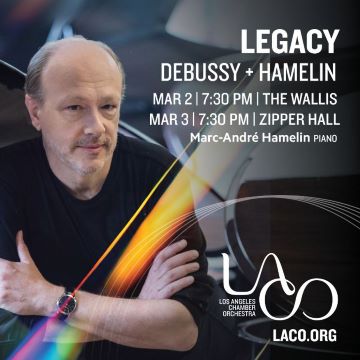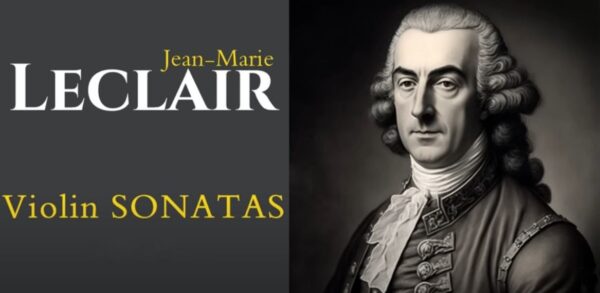WHAT’S ON THE MENU? FRANCK AND HAMELIN
Finally, I got to see pianist Marc-André Hamelin in person, thanks to the Los Angeles Chamber Orchestra, which presented him in two of four salon pieces that made up Legacy: Debussy + Hamelin — a program which which played last Saturday at The Wallis, a great venue for LACO’s salon series (Legacy also played Colburn’s Zipper Hall last Sunday). The Montreal native and superstar more than impressed with the quality of his sound. Along with players from LACO, he first played Three Pieces for Cello and Piano with the great Andrew Shulman, and then finished off the evening with César Franck‘s Piano Quintet in F minor. But allow me to go in order of the four pieces.
The all-French selections were made by director of chamber music Margaret Batjer, who introduced the works for us. The first was by Jean-Marie Leclair, who was born in Lyon, France, in 1697. An unfamiliar name, perhaps, outside of chamber aficionados, but he’s a fascinating figure: not only is the composer widely considered the father of French violin playing, but he was once the principal dancer and ballet master of the Teatro Regio in Turin. The literate man from a musical family (four of his five siblings would become professional musicians) came to a mysterious end in 1764 he was found stabbed to death outside his home — was it an ex-wife, a gardener, a nephew? It remains unsolved.
What is certain is the mastery of his compositions. Among them, he completed four books of violin sonatas, one book of trio sonatas for two violins, and two books of sonatas for two violins (without basso continuo). The piece we heard tonight is the fifth from the first set of two-violin sonatas, the only work in the set cast in a minor key. Maia Jasper White and Susan Rishik gave us a masterful, powerful rendition of his Opus 3, No. 5 sonata for two violins, a beast which may be the most difficult of the six sonatas in Opus 3. All three movements seemed to envelop many attributes from Leclair’s life, including the scandals; it was lilting, graceful, and fiery. So, too, were White and Rishik, who constantly played off each other, whether sharing humor or a tender moment, or engaging in debate. They ensured that both the first and second violin parts were always of equal importance, continuously interjecting and mimicking each other, but never sounding identical; each player had her own character and contribution to make. The rapid passagework in often simultaneous 16th notes in the last movement, Presto, was the highlight of the night. And, as always, with LACO players, they made it look easy.
First page of Sonata in E Minor for Two Violins, Op. 3, No. 5 (1730)
Next up in the intermissionless evening was Nadia Boulanger‘s Trois Pièces for Cello and Piano (1914). A French composer and pedagogue, Boulanger was also the first woman to conduct some of the major orchestras across the world. The first of three short, stand-alone, post-impressionist pieces is delicate and mysterious, the second a peaceful lament, followed by a frantic finale. Shulman’s lush, dreamy and melancholic playing offered long lyrical cello lines above Hamelin’s rippling accompaniment from the piano. The second piece is conversational, with the instruments echoing each other’s phrases; their musical partnership was supple and supportive; they matched each other in phrasing and attitude and tonal weight. The finale is a bit more fierce as it anticipates the 1920s modernism of composers like Ravel but I can’t call their playing muscular or extroverted. In other words, there was no showiness. Both players are astonishingly sophisticated musicians, as precise and technically perfect as the music.
Next up was Claude Debussy‘s Sonata for Flute, Viola and Harp (1915) (I don’t have to explain who Debussy was, right?). This piece — one of the last pieces the French master wrote before he died of cancer during WWI — is at once eloquent, poignant and eagerly enigmatic, and also seemingly less harmonically adventurous than his other works. I kept asking myself, what time are we in? It seemed to me like a work written outside of time with abstract, non-representational movement, hardly impressionistic at all. Individually, Ben Smolen, flute, JoAnn Turovsky (harp), and Rob Brophy (viola) were as fine as we would expect; they are an elite trio of players. Being my first time hearing it, I can only assume that this is a tough piece to get a blended sound. We are hearing a vibrant musical conversation (Debussy invented the combination of flute, viola and harp), but the individual volume of the players could have used fine-tuning, as more than a few times an instrument would get lost in the mix. Perhaps this sonata takes a bit of getting used-to. Melody and harmony take a back seat to tonal color and atmosphere.
Tereza Stanislav, violin; Joel Pargman, violin; Marc-André Hamelin, piano; Andrew Shulman, cello; Yura Lee, viola
Countryman César Franck is, regrettably, a much less familiar composer than Debussy save the Symphony in D minor or, perhaps, his orchestral poem Le Chausseur Maudit (The Accursed Huntsman). The Piano Quintet in F minor is a big, beautiful and passionate work; one that actually earned the composer a lot of vilification at the time for its sweeping Romanticism — as LACO’s program notes tell us – simply not “French” enough, it seemed. Ha! Critics! Well, if you believe what I say, than believe me when I tell you that you would be hard-pressed to find a more cohesive string quartet than the one led by violinist Tereza Stanislav, which included violinist Joel Pargman, violist Yura Lee (a knockout in pink hair and matching Cheshire Cat dress) and cellist Shulman. Their opening register was gripping, a sinister growl that would define the work’s starkly sombre tone.
Tereza Stanislav, violin; Joel Pargman, violin; Marc-André Hamelin, piano; Andrew Shulman, cello; Yura Lee, viola
At first, Hamelin’s piano entry was almost mellow, but soon he added to the music’s mesmerising intensity with phenomenal fingerwork. He integrated beautifully with the strings, rather than stand out as a soloist, even with the piano lid up. This unity brilliantly bore out the music’s unfolding upheavals and turmoil without letting up for a moment. The quintet achieved transcendent beauty in the slow movement, during which Stanislav’s violin sang out. The calm was broken with the final movement’s manic march to the edge of sanity, with a terrifying sense of momentum. The five musicians were fully in control while the music seemed to hurtle dangerously towards parts unknown.
Is that why its original dedicatee, the genteel Camille Saint-Saëns, was so incensed that he stormed out after its premiere? At this evening’s commanding performance, I left with nothing less than total satisfaction and admiration.
photos by Gabriel Gomez taken at Colburn’s Zipper Hall


